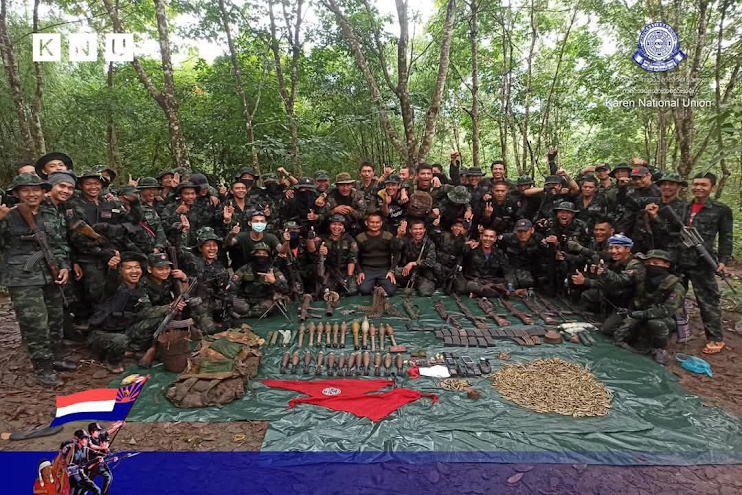Myanmar Spring Chronicle – March 25 Overview
MoeMaKa, March 26, 2025
The Battle for Khale Day Camp and the Karen Revolution’s Journey
Reports indicate that the Karen National Union/Karen National Liberation Army (KNU/KNLA) successfully captured the Khale Day military camp on the afternoon of March 25. This camp, located in Hpa-An District near the Thai border, was one of the last remaining military junta outposts along the border. In recent years, the KNU had already taken over several border camps, and Khale Day was one of the last remaining outposts under junta control.
According to territorial designations, Khale Day falls within the jurisdiction of the KNU/KNLA Brigade 7. Since the 2021 military coup, Brigade 7 has seen the least amount of conflict compared to other brigades. Most intense battles occurred in the territories of Brigade 1, Brigade 5, and Brigade 6, whereas Brigade 7 remained relatively quiet in 2021 and 2022.
Looking at regional trends, clashes between the military junta and KNU/KNLA forces have been most frequent in Karen State, Mon State, and Bago Region. Over the past few years, there have been heavy battles in Myawaddy, Kawkareik, Kyarinseikgyi, Thaton, and areas along the Sittaung River in Bago, such as Kyaukkyi and Moen. These conflicts have displaced tens of thousands to hundreds of thousands of civilians.
Before 2021, the KNU/KNLA was a signatory to the Nationwide Ceasefire Agreement (NCA), engaging in peace negotiations with the previous government. However, after the military coup, it provided refuge and support for those opposing the junta, including training resistance fighters. The group has since worked closely with the National Unity Government (NUG), securing territory under its control.
Challenges in Expanding Territory
The KNU/KNLA is the oldest ethnic armed group in Myanmar, but unlike some other ethnic resistance forces, it has not managed to capture major towns or vast territories since the coup. One major reason is the fragmentation among Karen armed groups, which have different objectives and, in some cases, even conflict with one another.
Despite being the largest Karen armed group, the KNU/KNLA faces competition from other factions, such as the Democratic Karen Benevolent Army (DKBA) and the Border Guard Force (BGF) led by Saw Chit Thu. These groups, which split from the KNU in the 1990s, have maintained close ties with the military junta and engaged in various economic activities, including illicit trade, to strengthen their forces.
Additionally, within Brigade 7’s territory, there are smaller splinter groups like the KNU/KNLA Peace Council (led by former commander Col. Thain Maung) and the Klohtoobaw Karen Organization (KKO) led by Col. Khlo Htoo Baw. Another significant force is the Kawthoolei Army (KTLA), founded by Col. Nel Dar Mya, the son of former KNU Chairman Gen. Mya. KTLA has been more active in Tanintharyi Region in recent years.
The presence of these rival groups creates significant obstacles for the KNU/KNLA in its efforts to seize towns and expand its control.
The Geopolitical Dimension – China’s Influence
The future of Myanmar’s armed conflicts is closely tied to China’s strategic interests. In the country’s northeast, ethnic armed groups benefit from China’s indirect support, provided they do not threaten its interests. This is why the northern ethnic resistance groups have been able to sustain their movements with relative stability.
Although the KNU/KNLA operates along the Thai border and is not directly linked to China, its activities are still influenced by broader regional dynamics. China remains wary of armed groups that have relationships with Western countries and takes measures to prevent alliances between its border-based forces and other ethnic armed organizations.
While the KNU/KNLA is not yet directly connected to resistance operations in central, northern, or western Myanmar, it plays a crucial role in the southern front, exerting pressure on the junta and restricting its territorial control.

